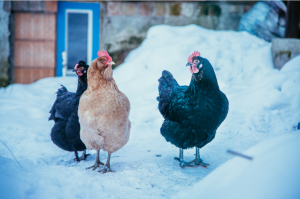Winter weather is quickly approaching here in northwest Indiana, so this means it’s time to prepare our coops for the season to come. Now, surprisingly enough, chickens are very cold hardy animals. If you think about it, all those feathers act like little down jackets. While your flock may not like the cold and snowy conditions, they can easily survive in blistery temperatures – especially when you set them up for success from the get-go. Here are a few of my favorite ways to winterize your coop and ensure that your flock stays comfortable this season.
Start from the inside – When it is flat-out miserable outside, your chickens may choose to hangout in the coop rather than deal with the conditions Mother Nature has brought upon. With that being said – have you ever heard the expression “being all cooped up”? Take a second and reflect on how that affects you when you’re cooped up somewhere. Is it enjoyable? Do you have everything you need to keep you satisfied? Now take those questions and apply them to your flock. If your flock seems to be hanging out inside more than usual be sure that their food and water are accessible from the inside. If you have some extra room in the coop, consider some “chicken approved” activities – extra roosting poles, hanging treats, and other boredom busters are all great options to help pass the time!

Prevent cold drafts – Does your coop allow cool air inside through any holes or cracks? If so, keep in mind that cold air drafts will quickly chill the chickens inside. Plan on sealing any holes the best you can. There are many ways to prevent cold drafts. Plywood, tarps, and strong plastic sheeting are all sufficient draft stoppers! Your chicken coop’s roof should already be waterproof, but if you notice any holes, seal those up to the best you can, but be sure not block off the ventilation openings.
Proper ventilation – Good ventilation is an absolute must all year around, but during the winter months is especially important. Poor ventilation can cause stagnate moist air inside the coop. A combination of ammonia and moisture from their droppings will increase the risk of mold inside the coop. This can cause respiratory infections and also frostbite on their combs and wattles. So, please make sure your coop maintains good ventilation and low humidity.
Added insulation – Through the colder months, I like to place additional insulation inside and outside of the coop. For the outside of the coop, I line the exterior with bales of straw to help as a barrier to the wind and any drafts that may enter without it. It also helps keep the heat produced from your flock inside the coop. On the interior, I like to add a thick layer of bedding to the coop floor such as shavings. You can also choose to follow the “deep litter” method, so rather than regularly cleaning out the coop, continue to add more fresh bedding on top of soiled bedding. This provides extra insulation, and also produces some heat as microbial activity increases to breakdown the waste. If you choose to follow this method, do note that it can increase the level of humidity in your coop.
Adequate roosts – Your coop should already be equipped with roosting poles, but if not, make sure you add some before the cold arrives! Roosts are essential to helping keep your flock warm. Make sure they are placed at least 2 feet above the ground, this keeps them off the cold floor. Roosts also give chickens a place to fluff out & snuggle up to their friends. Also remember, there is warmth in numbers!
Outdoor space – In addition to winterizing your coop, winterizing their run or other outdoor space is also a great idea. Just like the coop, tarps and heavy plastic sheeting can be used to cover the top or sides of the run. This provides great protection from rain, snow, and wind. You can also lay down straw in the run to give them a place to romp around comfortably. Their feet are susceptible to frostbite, so make sure to do a routine check on the flock.
Lighting in the coop – Cold weather can definitely reduce egg production, but darkness is the main reason production drops off in late fall. Chickens lay best when they receive at least fifteen hours of sunlight per day. To get the best egg production during the shorter days, adding artificial sunlight to the coop is a great option. You can achieve this by hanging a light, controlled by a timer, near your nesting area to add “daylight”. This is an easy solution to increase egg production through during shorter days!
With a little bit of preparation, you can now go into winter confidently knowing that you have met all the needs of your flock this season! I hope these tips are as beneficial to you as they are to me! Have the BEST day!